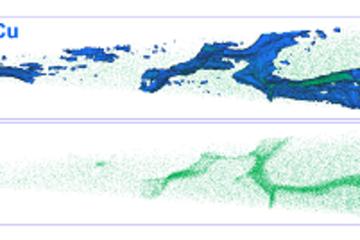All genres
1.
Journal Article
Development of an atomic cluster expansion potential for iron and its oxides. npj Computational Materials 11 (1), 81 (2025)
2.
Journal Article
Electric field induced formation of a two-dimensional adatom gas on cryogenic Li surfaces. Physical Review B 112 (11), 115426 (2025)
3.
Journal Article
Temperature and misorientation-dependent austenite nucleation at ferrite grain boundaries in a medium manganese steel: role of misorientation-dependent grain boundary segregation. Acta Materialia 296, 121242 (2025)
4.
Journal Article
Ultrastrong and ductile CoNiMoAl medium-entropy alloys enabled by L12 nanoprecipitate-induced multiple deformation mechanisms. Journal of Materials Science & Technology 225, pp. 72 - 86 (2025)
5.
Journal Article
Automated generation of structure datasets for machine learning potentials and alloys. npj Computational Materials 11 (1), 174 (2025)
6.
Journal Article
Hydrogen accommodation and its role in lattice symmetry in a TiNbZr medium-entropy alloy. Acta Materialia 288, 120852 (2025)
7.
Journal Article
Chemical ordering and magnetism in face-centered cubic CrCoNi alloy. npj Computational Materials 10 (1), 284 (2024)
8.
Journal Article
Accelerating ab initio melting property calculations with machine learning: application to the high entropy alloy TaVCrW. npj Computational Materials 10 (1), 274 (2024)
9.
Journal Article
Automated optimization and uncertainty quantification of convergence parameters in plane wave density functional theory calculations. npj Computational Materials 10 (1), 263 (2024)
10.
Journal Article
From electrons to phase diagrams with machine learning potentials using pyiron based automated workflows. npj Computational Materials 10 (1), 261 (2024)
11.
Journal Article
Revealing the Reaction Pathway of Anodic Hydrogen Evolution at Magnesium Surfaces in Aqueous Electrolytes. Journal of the American Chemical Society 146 (44), pp. 30314 - 30319 (2024)
12.
Journal Article
Metastable defect phase diagrams as roadmap to tailor chemically driven defect formation. Acta Materialia 277, 120145 (2024)
13.
Journal Article
Machine Learning-Enabled Tomographic Imaging of Chemical Short-Range Atomic Ordering. Advanced Materials 36 (44), 2407564 (2024)
14.
Journal Article
Enhancing corrosion-resistant alloy design through natural language processing and deep learning. Science Advances 9 (32), eadg7992 (2024)
15.
Journal Article
Quasi-“In Situ” Analysis of the Reactive Liquid-Solid Interface during Magnesium Corrosion Using Cryo-Atom Probe Tomography. Advanced Materials 36 (32), 2401735 (2024)
16.
Journal Article
Roadmap on Data-Centric Materials Science. Modelling and Simulation in Materials Science and Engineering 32 (6), 063301 (2024)
17.
Journal Article
Comparative analysis of surface phase diagrams in aqueous environment: Implicit vs explicit solvation models. The Journal of Chemical Physics 160 (16), 164715 (2024)
18.
Journal Article
Effect of Sn on stacking fault energies in zirconium and its hydrides. Physical Review Materials 8 (3), 033605 (2024)
19.
Journal Article
Melting properties of the refractory metals V and W and the binary VW alloy fully from first principles. Physical Review B 109, 094110 (2024)
20.
Journal Article
Understanding atom probe’s analytical performance for iron oxides using correlation histograms and ab initio calculations. New Journal of Physics 26 (3), 033021 (2024)











